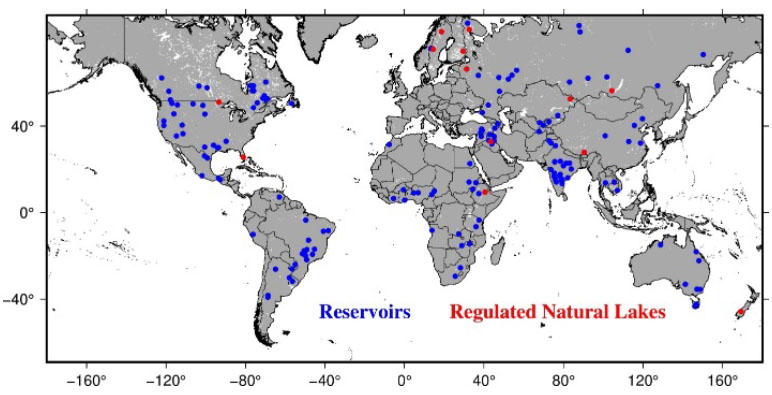NASA Water Reservoir Products
Product User GuidePI - Huilin Gao (Texas A&M University)
Product ATBD
The Collection 2.0 VIIRS Global Water Reservoir (GWR) product (VNP28) covers 164 reservoirs, including 151 man-made reservoirs (2,672 km³) and 13 regulated natural lakes (23,811 km³). The total storage capacity of man-made reservoirs represents 45.82% of the global capacity in this category, as per the Global Reservoir and Dam Database (GranD). The user guide and ATBD include geographical locations and attribute information for these 164 global reservoirs, which were selected from the GRBD for having areas larger than 25 km². The product is limited to these large reservoirs due to the availability of reliable area-elevation curves. The VIIRS GWR product includes time series of surface area, elevation, storage, evaporation rate, and volumetric evaporation at two temporal resolutions. Both 8-day and monthly products include reservoir area, elevation, and storage records, with the monthly product additionally featuring reservoir evaporation rate and volume records.

The VIIRS GWR product (VNP28) is developed using refined algorithms based on those used for the Collection 6.1 MODIS (MOD28) GWR Product. These refinements improve performance by addressing terrain shadow effects, enhancing the classification algorithm, and providing better quality assessment information for end users. The reservoir surface area algorithm employs image classifications of NIR reflectance from both the Suomi National Polar-orbiting Partnership (SNPP) (VNP09H1) and the Joint Polar Satellite System (JPSS) 1 (also known as NOAA-20) (VJ109H1). Storage and elevation values are calculated by applying the area to pre-established Area-Volume-Elevation (AVE) curves for each reservoir. The VNP28 reservoir evaporation rate is estimated using the newly developed Lake Temperature and Evaporation Model (LTEM), which utilizes VIIRS LST data (VNP21A2 and VJ121A2) to constrain the modified Hostetler Model for calculating lake water temperature profiles. These temperature profiles are then used to calculate the lake heat storage change term in the Penman equation. The evaporation rate calculation also requires gridded meteorological inputs from GLDAS and bathymetric data. The volumetric evaporation is calculated as the product of the evaporation rate and open water area.
To enhance utility and accessibility for a wider user base, an interactive website (https://landweb.modaps.eosdis.nasa.gov/lake) has been created, allowing users to generate plots and download reservoir-specific time series from the MODIS and VIIRS Water Reservoir products easily. These reservoir observations support various applications, including hydrological monitoring and modeling, water resources management, and Earth system modeling.
See the links below to the Product Description pages posted at the LP DAAC (product details and data access links).
Product Details and DAAC links
| Product Name | SNPP | JPSS-1 |
|---|---|---|
| Reservoir area, elevation, and storage 8-day L3 500 m | VNP28C2 | VJ128C2 |
| Area, elevation, storage, evaporation rate, volumetric evaporation Monthly L3 500 m | VNP28C3 | VJ128C3 |
References
Shah, D., Zhang, S., Sarkar, S., Davidson, C., Zhang, R., Zhao, M., ... & Gao, H. (2024). Transitioning from MODIS to VIIRS Global Water Reservoir Product. Scientific Data, 11(1), 209.
Li, Y., Zhao, G., Shah, D., Zhao, M., Sarkar, S., Devadiga, S., ... & Gao, H. (2021). Nasa’s MODIS/VIIRS global water reservoir product suite from moderate resolution remote sensing data. Remote Sensing, 13(4), 565.


